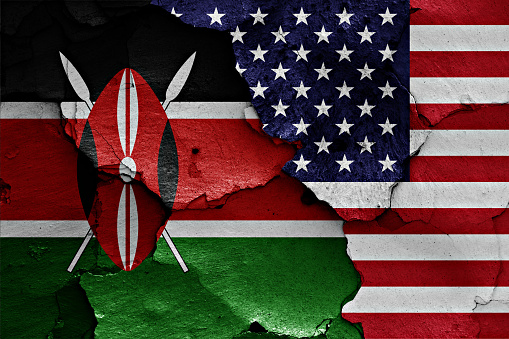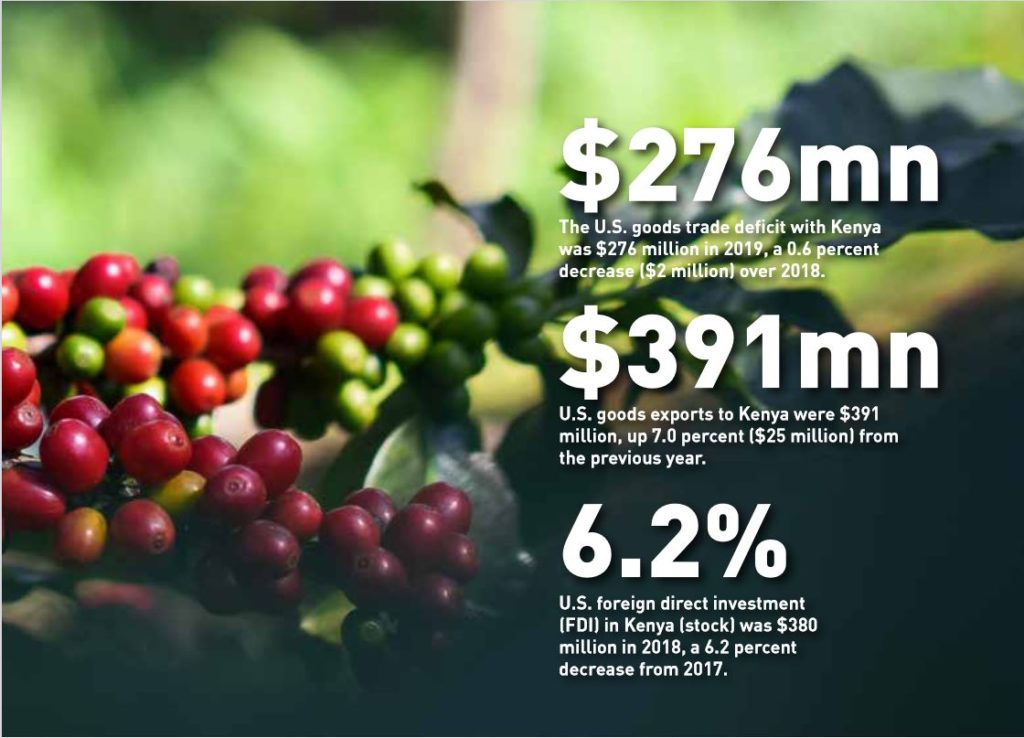FTA Series – Part 5: Impact of US-KE FTA on agriculture

“It’s impossible to overstate how much Congress cares about agriculture – US agriculture is very productive, and we now want to work out how to sell it.” – A Senior USTR Adviser, 2020

In last week’s feature, we focused on unpacking the US-KE FTA and provided general highlights of the pros and emerging concerns with regards to the ongoing negotiations. In this week’s feature, we shall focus on the likely impact that the US-KE FTA will have on agriculture and ICT. The focus areas are informed by the amount of trade between the two countries in agriculture and the ongoing developments in the taxation of the digital economy within Kenya.
As highlighted in Part 4 of this series, according to data from the Kenya Private Sector Alliance (KEPSA), total exports to the US from Kenya in 2019 were valued at $667million where nearly 70% ($453.73 million) were apparel items. Other goods exported included edible fruit & nuts (cocoa, brazil, cashew) (valued at $74 million); coffee, tea & spice (coffee) ($50 million); and special other (returns) ($55 million). This made Kenya the number one apparel exporter in Sub-Saharan Africa to the US which is the largest apparel market globally with a market value of $343 billion.
This compared to 2018 where US total imports from Kenya totaled $644 million being a 3.4 percent increase in trade with agricultural products accounting for $154 million. Leading categories included: tree nuts ($75 million), coffee, unroasted ($43 million), tea, including herb ($17 million), essential oils ($11 million), and other vegetable oils ($3 million).
The expansive potential of agriculture to not only grow but also sustain the Kenyan economy cannot be gainsaid.
Currently, it is estimated that the sector accounts for approximately30 per cent to the country’s GDP. Even with these statistics, the sector remains under-utilized despite having the potential to alleviate poverty and engage the unemployed youth.
Kenya’s youth unemployment (15 – 34 years) is estimated at 67% and a total of 1.3 million jobs are required to be created annually to ease this pressure. Agriculture has the capacity to reduce these numbers significantly. For instance, according to a 2018 study by the Kenya Association of Manufacturers (KAM) and the Kenya Business Guide, EPZ based manufacturers employ 52,000 people. The local sector directly employs about 21,000 people in formal sector and over 30,000 informally. The two sub sectors cumulatively employ over 200,000 indirectly. Further, 40,000 cotton farmers are currently engaged.
Within the negotiations, focus has been placed on the apparel sub-sector owing to the huge market and the substantial share that Kenya has. Out of the $644 million exports from Kenya to the US in 2018 woven apparel contributed to $240 million and $153 million in knit apparel in comparison to $74 million in edible fruits and nuts and $50 million in tea, coffee and spice. In 2019, out of the total $667 million in US merchandise imports from Kenya nearly 70% ($453 million) were apparel items.
However, despite these significant figures and the sector’s potential, it could be fast curtailed by the ongoing negotiations of the US-KE FTA.
One of the key negotiation objectives of the US is to secure duty-free access to U.S. textile and apparel products and seek to improve competitive opportunities for export of U.S. textile and apparel product while taking into account U.S. import sensitivities.
In this regard, a lot of the textiles from the US imported into the country are usually used clothing which was having an adverse effect on local textile manufacturing. As a measure to correct this as well as being a first step to implement an EAC-wide import ban on these products, the Government of Kenya had in June 2016 doubled the import duty rate on articles of used clothing. In July 2017, however, in response to concerns of stakeholders, including U.S. exporters of used clothing, Kenya reverted to the pre-June 2016 duty rate on these products. In 2019, Kenya continued to apply the pre-June 2016 import duty rates. This is an issue that has been highlighted by US based exporters who as mentioned above are seeking duty-free access in order to export the US textile into the Kenyan market. This exposes the country on two fronts the first being the loss of revenue compared to the value of market share; and the multiplier effect due to the under-development of the apparel sub-sector.
There is also the concern with regards to the changes in the Rules of Origin (RoO). Presently under the AGOA framework, Kenya is a beneficiary to the Third-Country Fabric RoO under section 112(c) which in essence qualifies beneficiaries to utilize yarn and fabric from any origin. Between 2015-2019 99.7% of US apparel imports from Kenya claimed this benefit. This allowed for increased exports from Kenya, earnings in foreign exchange, created job creation opportunities and enhanced trade diversification. However, under the US-KE FTA more stringent measures are sought by the US Government which aims to develop rules of origin that ensure that the benefits of the Agreement go to products genuinely made in the United States and Kenya. This includes establishing origin procedures that streamline the certification and verification of rules of origin and that promote strong enforcement, including with respect to textiles.
Such provisions or requirements would significantly hamper any benefits that Kenya would be seeking to accrue from this trade agreement as they fail to recognize the significantly disproportionate economic levels of the two countries. Further this would exacerbate the existing challenges of limited industry upgrades and textile production (in)capacity.
“Africa does not currently have the capacity to produce the volume and variety of yarn and fabric necessary to support its apparel industry. Any tightening of the third-country fabric rule of origin in the post-AOGA model FTA would decimate the African apparel industry and lead to the loss of hundreds of thousands of jobs.” – The African Coalition for Trade representing businesses in several SSA countries (2020)
Whereas it can be argued that there are existing protectionist policies and legislative measures to protect local industry such as the 2010 Constitution of Kenya, 2015 Buy Kenya Build Kenya, 2016 Public Procurement and Asset Disposal Act; among others owing to the varying strength of the two countries, there is the real concern that the USTR negotiation objectives will carry the day. In one of the specific negotiation objectives of the USTR include non-discriminatory government protection rules for national level procurement. What this means is that the for instance the protectionist mechanisms provided for in the Public Procurement and Asset Disposal Act of 2016 reserving procurement preferences for Kenyan-owned firms and goods manufactured or mined in Kenya would also be applicable to US based firms.
A sample of how this would be phrased based on the United States-Mexico-Canada Agreement (USMCA) would be:
- for the Ministries listed, for the goods and services liberalised, for contracts above the threshold:
- national treatment for goods, services and suppliers
- no offsets
- Commitments by each country:
- Mexico: threshold: US$80,317; liberalised: all goods (except for Ministry of Defence & Navy which is positive list), negative list for services
- US: threshold: US$80,317; liberalised all goods and services
Another example is the provision in the Kenyan Constitution providing that foreigners cannot own land in Kenya, though they can lease it in 99 year increments.
Land is the largest and most vital agricultural farm input thus critical to these negotiations. Thus far, Kenya has indicated that it’s objectives would be liberal investment environment, negotiations to include liberalization and protection. However, upon closer scrutiny of the USMCA out of which the US-KE FTA is to be adopted, the chapter on Investment espouses texts such as: Non-exhaustive definition of ‘investment’; National treatment (NT) on a negative list basis and Fair and equitable treatment (FET).
The US has expressed its negotiation objectives in this regard as to:
- “Secure for U.S. investors in Kenya important rights consistent with U.S. legal principles and practice, while ensuring that Kenyan investors in the United States are not accorded greater substantive rights than domestic investors.”
- “Establish rules that reduce or eliminate barriers to U.S. investment in all sectors in Kenya”
Based on the foregoing, it would be crucial for the Kenyan negotiators to be wary and aim to advocate for admission of investments in accordance with its own national laws and regulations in order to establish some form of equal playing field.
“US negotiators don’t talk about ‘special relationships’ when they’re cutting a deal and asking the other side to concede.”- Jeff Schott, Peterson Institute for International Economics
Other than technical barriers/ phrasing concerns, there have been calls for more caution to be taken in protecting Kenya’s food security and sovereignty. On November 21st, 2012, pursuant to a Kenyan Cabinet decision and Presidential order, the Kenyan Ministry of Public Health ordered public health officials to remove from the market all foods, feed, and seeds derived from agricultural biotechnology and to ban genetically engineered (GE) food and feed imports. Despite announcing in August 2015 that the Kenyan government would lift the import ban on GE products by October 2015, the government maintained the ban throughout 2019. Kenya’s GE ban has blocked both food aid and commercial U.S. agricultural exports derived from agricultural biotechnology. The restriction affects U.S. exports of processed and unprocessed foods and feed ingredients, such as soy, corn, and distiller dried grains with solubles. The GE import ban also affects transshipment. Food aid shipments of GE commodities destined for inland east African countries, which would ordinarily enter through the Port of Mombasa, must be diverted to other ports or reformulated with non-GE commodities.
As a result of this, there has been a push for more indigenous farming (said to be healthier) which is largely dependent on the climate. However, the same has been met with major challenges associated with climate change which has made it difficult for farmers to scale food production to meet the standards and requirements for export.
With agriculture being touted as a key industry that stands to benefit from these trade negotiations, and the fact that the US is decades ahead with regards to GE and biotechnology and can thus easily drown out the Kenyan farmers, it will be critical for the Government to look into how to safeguard some aspects of its food sovereignty to not only protect farmers’ livelihoods but also its citizen’s health.
Moreover, a key area of concern is Kenya’s preparedness to benefit from the already agreed upon component of US-Kenya Air Transport Agreement. It has emerged in the recent passed that Kenya does not have planes big enough to export the goods directly to the US market. In addition, the cold value chain needed to ensure that the farm produce to be exported to the US is severely underdeveloped in comparison to the trade volumes needed to ensure that Kenya benefits from the FTA.
Conclusion:
Whereas there are significant benefits to the US-KE FTA, there are also major concerns on the impact that it will have on the overall economy. Bottom line is that the benefits of a trade agreement dependent on the following factors: the relative economic strength and weaknesses of negotiating partners; the quality and strength of their domestic industries; the quality and scope of the agreements; and the principles that underpin the agreement. These are key considerations that need to be had as the parties engaged in the process continue to negotiate if true benefit is to be derived for both countries.
Acknowledgements:
Some of the information herein provided has been collated from Kenya Association of Manufacturers, Kenya Private Sector Alliance (KEPSA), Third World Network, University of Arkansas- School of Law, National Trade Office of the President of the United States and the United States Trade Representative (USTR).

